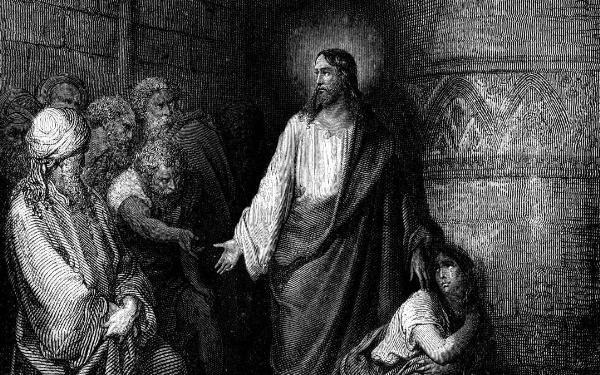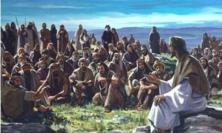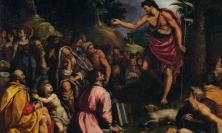
The gospel readings for the Sundays in Lent have so far been taken from Saint Luke, but on the fifth Sunday we will hear from the Gospel of John – although the particular passage bears many Lucan characteristics, suggests Jack Mahoney SJ. When the scribes and Pharisees presented Jesus with the woman caught committing adultery, how did his reaction epitomise the forgiveness of God that Luke has focused on in the Lenten gospels?
The gospel reading for the Fifth Sunday in Lent, the story of the woman caught in adultery and forgiven by Jesus, is remarkable in a number of ways, the first of which is that it appears to be in the wrong gospel! Since the third century this narrative has appeared as part of St John’s Gospel (Jn 7:53-8:11), but it is not at all like the rest of that gospel in terms of style or language, and it is not to be found in its early manuscripts. The passage is generally considered to be a late insertion in John, perhaps dating from the early Church’s controversy over the forgiveness of sins and the Council of Jerusalem’s apparent ruling that Christian converts should avoid ‘unchastity’ (porneia, Acts 15:29). This is often taken to refer to adultery, but in Thinking Faith, I explained why this interpretation of the Council is inaccurate. However, some Christians at the time may have wanted to preserve this story, going back to Jesus to argue that the Church should not be especially rigorous in its attitude to serious sexual sins, and they inserted it into the Fourth Gospel.
On the other hand, the style, significance and atmosphere of the story are remarkably similar to those of the stories we find in St Luke’s Gospel: in language and references, and in the way in which it shows the gentleness and the mercy of Jesus, especially in his dealings with women. In fact, it is actually found in some manuscripts of Luke’s Gospel, appearing very suitably after Lk 21:37-38 in a section describing Jesus’s actions in the Temple at Jerusalem. At one time, then, this striking passage appears to have been a popular and free-floating, self-contained story about Jesus which was considered very significant in illustrating his attitude to sinners. In time it came to settle in the Fourth Gospel as fitting not too inappropriately into the description there of the final confrontation between Jesus and his opponents in the Temple, ‘the scribes and Pharisees’ (Jn 8:3) – a phrase, it may be noted, which appears only here in John but is quite common in Luke.
The tension mounts
As we read this section of John’s Gospel we can sense the tension mounting between Jesus and his opponents in the religious establishment in Jerusalem. In earlier Sunday gospels taken from Luke we have seen how the journey to Jerusalem runs like a leitmotif through the narrative as Jesus moves gradually to his eventual destination (Lk 9:51; 13:22), where he intends to bring to a climax his prophetic mission to Israel to inaugurate the kingdom of God, and die in the process (Lk 19:28-46) as previous prophets have done (Lk 13:33). Having arranged to arrive in Jerusalem as preparations were beginning for the celebration of Israel’s major annual feast, the Passover, Jesus was teaching every day in the Temple to ‘spellbound’ audiences, who would include pilgrims arriving from all round the Mediterranean, as the plot to get rid of him began to take shape among his enemies (Lk 19:47-48).
In John’s Gospel the insertion of the episode concerning the adulterous woman is at the beginning of chapter eight (8:1), where Jesus is described as leaving the Temple in Jerusalem to spend the night at the Mount of Olives (as we know, from Luke, he usually did [Lk 22:39]) and returning the next morning to the Temple where ‘all the people came to him and he sat down and began to teach them’ (Jn 8:2). His teaching of this large attentive audience was suddenly disturbed when a gang of scribes and Pharisees barged in, dragging with them a distraught woman, and parading and shaming her in front of everyone. She had been apprehended, they claimed, in the very act of committing adultery, thus breaking the sixth commandment delivered by God to Israel (Ex 20:14). For this, they pointed out, Moses had decreed in the law the penalty of stoning to death (Dt 22:22). What, they asked peremptorily, did the learned ‘teacher’ have to say about this? (Jn 8:3-5).
John explains (8:6) that they said this to test Jesus and put him on the spot, a practice that we find Jesus’s enemies using against him regularly in the gospels, for example when they asked his views on the paying of taxes to the Roman occupying power (Mt 22:15-17). Here they were trying to force him to make a choice between on the one hand accepting the Mosaic law which ordered the woman to be stoned to death, and thus incurring Roman displeasure for flouting the ruling which forbade the Jews from inflicting the death penalty (Jn 18:31); and on the other hand, complying with the Roman ruling but disregarding the law of Moses, to the evident disapproval of his fellow-Jews. Jesus, however, appeared to ignore his questioners, bending down and writing with his finger on the ground (8:6); but they continued demanding an answer to their trick question. In the face of their persistence, Jesus eventually straightened up, looked at them and delivered the famous sentence, ‘Let anyone among you who is without sin be the first to throw a stone at her’ (Jn 8:7), and he leaned down again and resumed his writing on the ground. It appeared that Jesus was just quoting Dt 17:7, which ruled that ‘the hands of the witnesses shall be the first raised against the person to execute the death penalty’; but instead of just calling on the witnesses to the woman’s adultery, he was calling upon anyone who was sinless himself to begin to carry out the sentence, thus on his part challenging the woman’s accusers and unmasking their hypocrisy, on which we know he had strong views (Lk 6:42).
The writing on the ground
What was Jesus writing? Commentators cannot resist spending considerable ingenuity and ink trying to work out what it was that Jesus leaned down to write with his finger on the ground, with suggestions ranging from listing the sins of all the scribes and Pharisees who were there, to just ignoring them and showing his contempt for them by doodling in the sand. We simply cannot know; although I am attracted by the comparison with the writing which appeared mysteriously on the wall at Belshazzar’s feast, which the prophet Daniel interpreted as ‘God has numbered the days of your kingdom and brought it to an end; you have been weighed in the scales and found wanting’ (Dan 5:26-7). This would have been quite a comment to the Israelite establishment!
What was much more to the point, however, was that Jesus had turned the tables on his enemies. They gradually became aware of it, leaving the scene one by one starting with the eldest of the lawyers and religious leaders (Jn 8:9), who either had longer careers and more skeletons in their cupboards, or who were politically experienced enough to realise straightaway that they had been outwitted by this clever Galilean. The crowd seems to have dispersed also, for in the end ‘Jesus was left alone with the woman standing before him.’ (Jn 8:9) He straightened up again and then for the first time she was addressed as a human being rather than just a religious pawn in the plan of the scribes and Pharisees: ‘Woman, where are they? Has no one condemned you?’ (Jn 8:10). On this, two comments seem appropriate, the first being that the term ‘woman’ which Jesus used here was not disparaging or looking down on the woman taken in adultery. In fact, it is a typically Joannine addition, and in John’s Gospel this was the way in which Jesus addressed women with courtesy and respect, as with Mary Magdalene at his resurrection (Jn 20:15) and his mother both at Cana and from the cross (Jn 2:4; 19:26). Perhaps, then, the address ‘Lady’ would be more appropriate than ‘Woman’, as indicating Jesus’s simple respect for this woman. The other point is that when Jesus asks, ‘has no one condemned you?’ the Greek verb used, katakrinein, is often employed as a legal term to express the idea of accusing or, further, of finding guilty. So perhaps it is more accurate to understand Jesus as trumping the attempt of his departing enemies to trap him by saying, in strict accuracy, ‘So no one has found you guilty?’ since the case had collapsed against her. To which the woman replied, ‘No one, sir’ (Jn 8:11), using the term kyrie, or ‘Lord’, possibly in respect or reverence, but certainly in gratitude to this man who had saved her life or at least prevented further humiliation.
Jesus’s final words then were ‘Then neither do I condemn you’, or find you guilty. ‘Go your way, and from now on do not sin again’ (Jn 8:11). The implication is clearly that the woman had been sinning. As on other occasions, however, such as in his teaching on divorce or on paying Roman taxes, Jesus had here evaded the hostile question which had been put to him about observing the Mosaic law by changing the agenda and outflanking his opponents. As for the unfortunate woman before him, he was not so much concerned about her allegedly criminal action in infringing the law and legally meriting death – the ploy of his enemies – as about the sinfulness of her behaviour in devaluing her marriage and her husband, behaviour that Jesus now forgave, letting her go with the injunction that she should not repeat her adultery. A few verses later in this chapter of John, Jesus points out to his enemies, ‘I judge no one’ (Jn 8:15), a claim which may have helped to influence the insertion of this episode here in John’s Gospel. In itself the story bears no indication of when in Jesus’s public life the event it describes took place, although placing it here in John (and equivalently in Luke) dates it as happening in the period just before Jesus’s arrest. It is attractive, however, to think that the event may have actually occurred earlier in Jesus’s public life, and that the forgiven adulteress may well have become one of the many devoted women who, according to Luke, accompanied and supported Jesus and his apostles (Lk 8:2-3), and were also later present on Calvary even at his death (23:49).
In the liturgy of the feast of the Presentation of the infant Jesus by his parents in the Temple in Jerusalem, there is a charming citing of Psalm 84:7, applying it to what is concealed in the event: ‘The God of gods will be seen in Zion.’ In a similar spirit it is possible to identify Jesus’s defence and forgiveness of the sinful woman, as we have seen described in John’s Gospel, as a striking incarnational expression of the living God being truly present and active in his Temple. The point of the Church’s choice of this passage on the forgiving of the adulterous woman as the gospel reading for this Sunday’s Mass could not be more obvious at this stage in Lent: God’s forgiveness is always available.
Jack Mahoney SJ is Emeritus Professor of Moral and Social Theology in the University of London and author of The Making of Moral Theology: A Study of the Roman Catholic Tradition, Oxford, 1987.
![]() Keeping Lent with Saint Luke
Keeping Lent with Saint Luke
![]() The Temptation of Jesus
The Temptation of Jesus
![]() The Transfiguration of Jesus
The Transfiguration of Jesus
![]() ‘Repent or Perish’
‘Repent or Perish’
![]() The prodigal son and his jealous brother
The prodigal son and his jealous brother
![]() The Passion According to Saint Luke
The Passion According to Saint Luke





